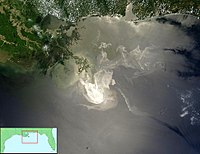
Photo from wikipedia
After Deepwater Horizon oil reached the Florida coast, oil was buried in Pensacola Beach (PB) sands to ~70cm depth, resulting in Total Petroleum Hydrocarbon (TPH) concentrations up to ~2kg per… Click to show full abstract
After Deepwater Horizon oil reached the Florida coast, oil was buried in Pensacola Beach (PB) sands to ~70cm depth, resulting in Total Petroleum Hydrocarbon (TPH) concentrations up to ~2kg per meter of beach. This study followed the decomposition of the buried oil and the factors influencing its degradation. The abundance of bacteria in oiled sand increased by 2 orders of magnitude within one week after oil burial, while diversity decreased by ~50%. Half-lives of aliphatic and aromatic hydrocarbons reached 25 and 22days, respectively. Aerobic microbial oil decomposition, promoted by tidal pumping, and human cleaning activities effectively removed oil from the beach. After one year, concentrations of GC-amenable hydrocarbons at PB were similar to those in the uncontaminated reference beach at St. George Island/FL, and microbial populations that disappeared after the oil contamination had reestablished. Yet, oxihydrocarbons can be found at PB to the present day.
Journal Title: Marine pollution bulletin
Year Published: 2018
Link to full text (if available)
Share on Social Media: Sign Up to like & get
recommendations!